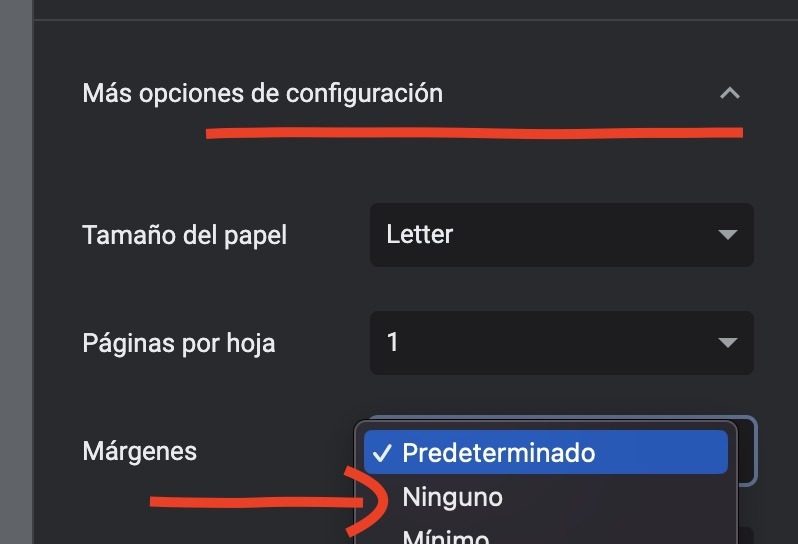English 4 Unit 2 Term 1 Week 2, 2025
Instrucciones:
• Los bloques sombreados en color gris se pueden ocultar en la impresión final.
• Para ello haga clic sobre cada uno de los bloques que desea ocultar.
• Para encenderlo nuevamente, pulse el bloque otra vez.
• Solamente los bloques encendidos serán impresos.
• Pulse el botón «Imprimir» cuando se encuentre listo.
• Para un mayor aprovechamiento del espacio, recomendamos eliminar los márgenes al imprimir.
¿Cómo guardar PDF?

Recomendamos utilizar el navegador Google Chrome.
Si no lo tiene instalado en su dispositivo puede descargarlo aquí.
El diálogo de impresión iniciará en cuanto cierre estas instrucciones.
En el cuadro de diálogo, cambie el destino de la impresión:

En las opciones, seleccione «Guardar como PDF»:

Para aprovechar todo el espacio de su hoja, recomendamos desactivar los márgenes:

Por último pulse el botón «Guardar»:

¿Cómo imprimir en color?

Recomendamos utilizar el navegador Google Chrome.
Si no lo tiene instalado en su dispositivo puede descargarlo aquí.
El diálogo de impresión iniciará en cuanto cierre estas instrucciones.
En el cuadro de diálogo de la impresión siga las siguientes instrucciones:
Si desea imprimir el planeamiento a color, asegúrese de activar la opción «Color»:

En la sección «Más configuraciones»:

Active la opción «Gráficos de fondo»:

Finalmente pulse el botón «Imprimir»:

School year: 2025
Period:
Term: I
Level: Forth Grade
Unit: 2
Week: 2
Domain: Socio-interpersonal
Scenario: Natural Treasures
Theme: Wildlife at the park
Enduring Understanding: National parks provide homes and food to animals and jobs, education and entertainment for people.
Essential Question: Why do national parks matter to us?
General Competences:
Responsible Citizenship ( X )
Life Competences ( )
Competences for Employability ( )
Learn to Know
Grammar & Sentence Frames
Simple present using (S-V-C) pattern
A monkey has a long tail.
Simple present tense
Monkeys eat bananas.
They climb trees.
Birds eat fruit.
Wh /information questions
What is Tortugüero like?
What can you do at Rincón de la Vieja National Park?
How can we preserve/protect our parks?
Vocabulary
Turtles, monkeys, sloths, snakes, squirrel, parrots, scarlet, macaws, crabs, crocodiles, raccoon, lizard, tiger, dolphin, bat, bug, white tail deer, quetzal, jaguar, birds, butterflies
Phonemic Awareness
/i/ pig, thin, fish
/a/ Hot, pot, lot
/Ʌ/ Sun, fun, cut
Learn to Do
Function
Asking for and giving information about places and things
Discourse Markers
Linkers: Sequential – past tense
First, then, after that, finally
Learn to Be and Live in Community
Psycho-social
- Taking pride in natural treasures in our country.
Socio-cultural
- Following conventions for turn taking
Idioms/phrases
Proverbs/idioms:
- “A breath of fresh air…” ( something new or different makes the experience more exciting)
Assessment Strategies & Evidences of learning
Learner…
L.2. Recognizes the main points in short, simple stories and reports.
Indicator of learning:
Recognizes the main points in short, simple stories about visits to National Parks.
Goals
Learner can…
L.2. understand the main points in short, simple stories and reports when there is some previous understanding of the topic and if they are read slowly, clearly and possibly repeated and accompanied with drawings and/or diagrams.
Pedagogical Mediation/ Didactic Sequence
Pre- teaching
Warm Up
Teacher asks students if they know what this question means:
“A breath of fresh air…”
She explains that it means to enjoy something new or different that makes an experience more exciting.
Students observe page 48 and name the different animals.
Students complete the page.
Activation of Prior Knowledge
Students observe page 38 and listen to the teacher reading the texts.
The teacher writes the vocabulary on the board.
Students try to recognize the vocabulary.
- Turtle
- Monkey
- Sloth
- Snake
- Squirrel
- Parrot
- crab
- crocodile
- lizard
- bug
- white tail deer
- butterfly
Students look for the vocabulary in the dictionary.
Modeling
The teacher writes a sentence using one of the words in the vocabulary.
Example:
The crocodile is near the river.
The teacher asks some students to try to make a sentence and write it on the board.
Clarifying
The teacher checks spelling and grammar.
The teacher explains details if needed.
Time
SI.1. Asks straightforward questions in familiar situations and understands the responses in an info-gap activity.
Indicators of learning:
Asks straightforward questions about Costa Rica’s national Parks in an info-gap activity
Recognizes what has been said about Costa Rica’s national parks in an info-gap activity
SP.1. Expresses common feelings during an oral presentation.
Indicator of learning:
Expresses how national parks make them feel, during an oral presentation.
SI.1. ask straightforward questions in familiar situations and understand the responses.
Pre-task
The teacher shows the National Park map to students.
Students name the different parts in the map.
The teacher shows the different animals in the animal sheet. Students name the different animals.
Task – Rehearsal
The teacher reads the following sentence.
The snake is near the volcano.
The students have to look for the snake in the map.
Task completion
Students color the map and the animals.
Students cut out the animals.
The teacher reads the script and the students paste the different animals in the appropriate space according to the text.
Students check the position where they glued the animals with a partner.
The teacher reads the script one more time and checks with them the position in the map of the different animals.
Task – Assessment
Students complete the gaps with the information the teacher said about the National Park.
Post task
Students can add some of the items on page 37 to the map such as pic nic area, restrooms, camping area, and warning signs.